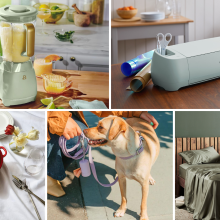Anyone who has attempted to cook in a very tiny kitchen (hi, it’s me) knows the struggle of how quickly that space can heat up, especially when you have both an oven and a gas cooktop going.
But what if you could cook wherever you have the space to place a burner — and eliminate those pesky flames from the equation altogether?
Well, whether you’re working with an incredibly small kitchen, need some extra cooking space when entertaining a crowd, or taking your home-cooked meals on the go, a portable induction cooktop offers a sleek and simple solution for crafting hot meals wherever you have access to an electrical outlet.
What is an induction cooktop?
An induction cooktop, sometimes called an induction burner, is a type of electric cooktop that only heats up when there’s a compatible pot or pan placed on its surface. It’s quick to heat up, emits no heat to the surrounding space, and is relatively safe compared to other cooking methods. It also requires no gas, propane, or flame, and its temperature control is often far more precise than other cooktops.
Built-in induction cooktops exist — often in high-end kitchens — but portable induction burners bring this clean and convenient technology to the rest of us plebes as we just try to level up our at-home (or on-the-road) cooking skills.
“If you have small cookware, you'll want to look for a model with a smaller cooking surface area,” Golden advises.
Not only can it turn your tiny apartment or dorm room “kitchen” into a functional cooking space, it’s also a great solution for RVs, boats, and camping — or “glamping,” to be precise. Because many portable induction cooktops are so travel-friendly, they’re a great solution for keeping dishes warm at a potluck dinner or other event, too.
What's the difference between an induction cooktop and an electric one?
The biggest difference between an electric cooktop and an induction burner is in the way the heat is transferred. While induction cooktops are also powered by electricity, they harness the power of electromagnetism at their core. They’re made with copper coils inside, which create a magnetic current when the appropriate cookware is placed on its surface. The pot or pan is heated directly, and the cooking surface does not get hot to the touch like an electric burner does. An induction burner also draws less energy and doesn’t emit heat into the surrounding space.
Are gas stoves bad?
With recent considerations into the federal banning of gas stoves, the potential health risks ascribed to the staple kitchen appliance have understandably come under fire (pun unfortunately intended).
A December 2022 study in the International Journal of Environmental Research and Public Health found that nearly 13% of current childhood asthma cases in the US are attributable to gas stove use. Furthermore, a PSE Healthy Energy study found benzene in 99% of samples it took in homes in California, and subsequently found that gas stoves can emit as much benzene as a cigarette — akin to secondhand smoke — even when the stove is turned off. So, if you wouldn’t invite your chain-smoking aunt to come sit in your kitchen while you cook, it definitely makes you wonder why we let our gas stoves get away with having a potentially similar impact on our health.
That said, Richard Trumka, a U.S. Consumer Product Safety commissioner, recently assured CNN that it’s highly unlikely we’ll all need to get rid of our existing gas stovetops. However, there’s certainly no harm in looking into alternative cooking methods, such as portable induction cooktops.
What should I look for when buying a portable induction cooktop?
If you’re ready to give induction a spin, you’ll want to keep a number of factors in mind as you shop for the best portable induction burner for your needs. To find out which features were most important, we spoke to Jessica Randhawa, the head chef, recipe creator, photographer, and writer behind The Forked Spoon; Jasmine Golden, owner at Golden Truffle; and Andrew Forlines of Chef AF, a fine dining chef turned home kitchen cooking technology expert.
Here’s what these pro recipe developers had to say:
Wattage. Higher maximum wattage means higher maximum power, which is ideal for fast heating as quickly as possible. That’s great if you need to boil a pot of water, for example — but a maximum of just 1400 watts should be fine for all other use cases. The power output on an induction burner can typically be adjusted so you can better control heat output and energy usage. This comes in especially handy in cases where you may have lower amperage, like in an RV or on a boat.
Temperature control. Most, if not all, portable induction burners come with a certain number of preset temperature levels. Randhawa recommends getting a cooktop with at least ten settings so you have fairly precise control of the temperature for a wide variety of recipes.
Forlines agrees, recommending an induction burner that can be set by temperature — not just low, medium, and high settings. Some induction cooktops offer even greater control and precision, allowing you to fine-tune the temperature in increments of five or 10 degrees.
Temperature range. Most portable induction burners can be set from 140–450°F, though some models can get as high as 575°F and as low as 100°F.
“I like a very low heat output so that I can melt chocolate directly in a pot or pan, and hold it melted without scorching it,” says Forlines. A low heat setting is also ideal for melting butter and keeping dishes warm for serving.
Even heat distribution. It’s important to consider the size of the pots and pans you use most often. Some induction cooktops cannot accommodate cookware with larger diameters because the inner coil is simply not large enough to evenly heat the entire bottom surface, leading to cold spots around the perimeter and scorched food closer to the center.
“If you have small cookware, you'll want to look for a model with a smaller cooking surface area,” Golden advises. “Or, if you plan to cook two items at once, make sure the cooktop has dual-burner capability."
Ease of use. Portable induction burners are typically pretty easy to use, but consider how many buttons are on the interface and whether or not they are well-labeled. Also, keep in mind that touchscreen displays look sleek and are easy to clean, but they can be a little more finicky when you try to use them with wet hands (which is, of course, a common occurrence when cooking). If you foresee that being a big issue, you may want to opt for a device with buttons or knobs instead.
Noise level. Portable induction cooktops can be surprisingly noisy — especially when set to their highest wattage — as the interior metal components vibrate and potentially give off a slight squealing sound. Forlines also notes that the fan that cools the cooktop can get a bit loud in some models as it kicks on to protect the device from overheating.
Safety features. Induction cooktops are comparatively pretty safe due to the fact that they don’t heat up like gas or electric burners (though the induction surface can remain hot for a bit after cooking). That said, there are still some safety features you’ll want to look out for.
“Always be sure to get a portable induction cooktop with an automatic pan section shut-off system,” advises Randhawa. “The system will automatically shut off if no pan is detected after a short period.”
Golden agrees, adding that the auto-shutoff safety feature should also kick in if the cooktop is left unattended for too long, or if it detects an unusual temperature increase. She also notes that some cooktops come with a child safety lock, which is crucial if you have little ones in your home.
Portability. Depending on your intended usage, this may not matter so much. But if you’re planning on taking your induction cooktop anywhere but your kitchen countertop, you’ll want a device that isn’t too heavy or bulky.
Why are induction cooktops not popular (yet)?
It’s important to keep in mind that induction cooktops only work with certain cookware. In order for the electromagnetism in the burner to activate, your pots and pans will need to contain enough iron to create a magnetic field. You may already have induction-compatible cookware in your kitchen, however — namely cast iron, carbon steel, and magnetic stainless steel pots and pans.
While they’re not the most popular cooking surface at the moment, induction cooktops are absolutely growing in popularity, especially as folks look to move away from gas burners. And with so many affordable, portable options on the market, now’s the perfect time to give one a try.


























